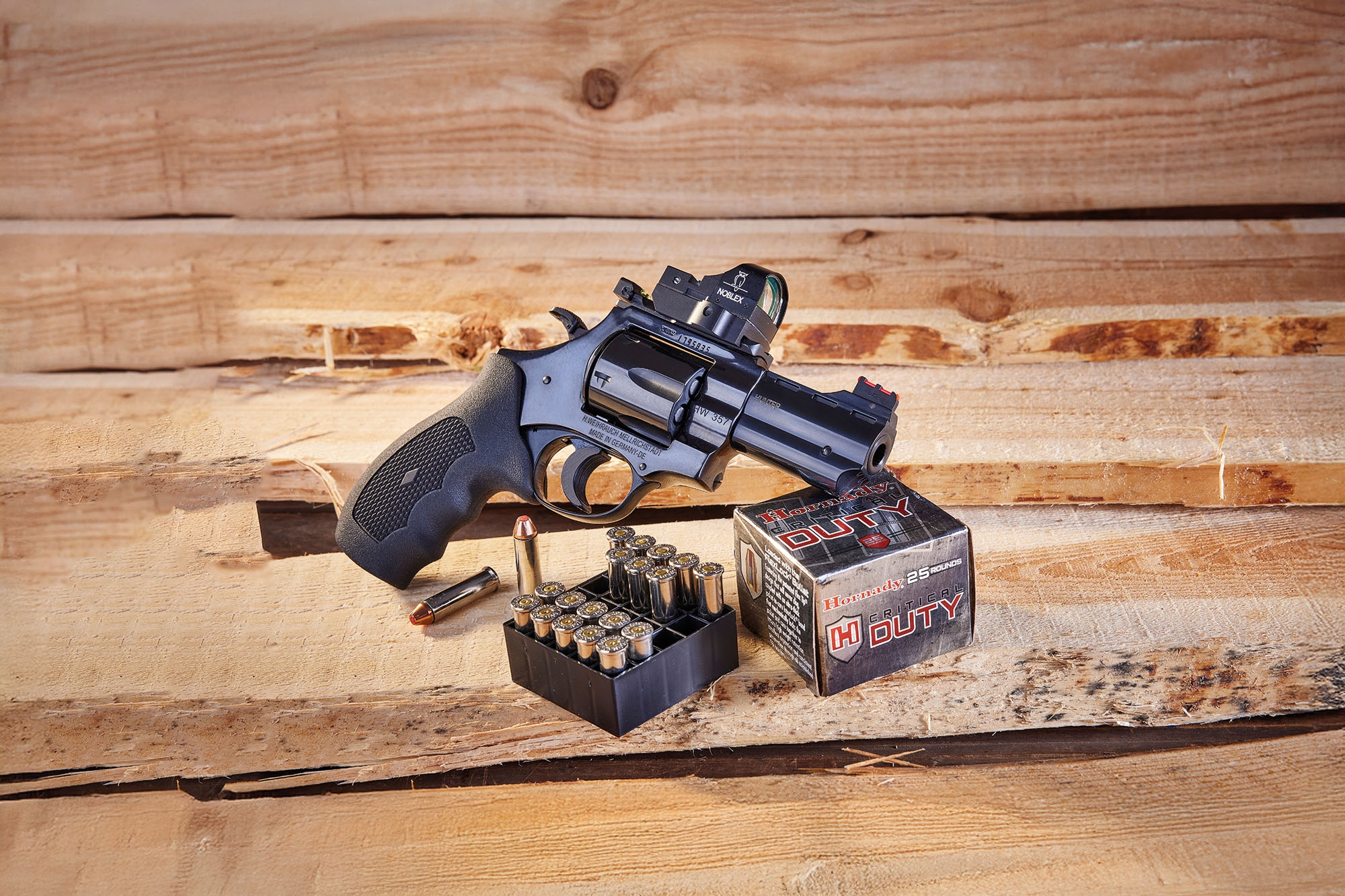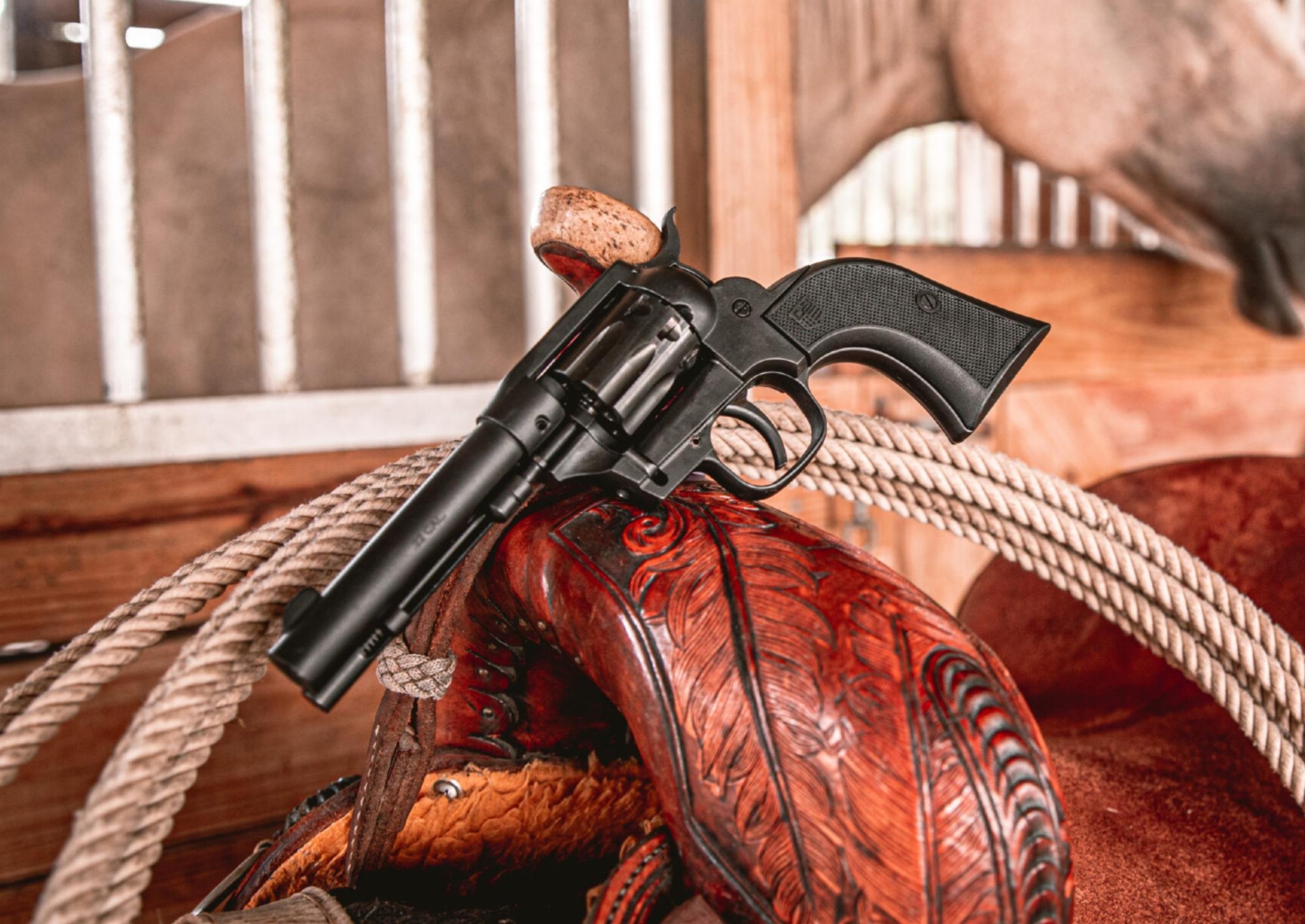
Coincidence or not, Spohr's first production-ready .44 Magnum revolver arrived to coincide with the 70th anniversary of "Dirty Harry's" cartridge, the legendary .44 Remington Magnum (aka .44 Magnum), which saw the light of day in 1955.
The history of the German .44 Magnum revolver began early on, as the qualified firearms technician and master gunsmith Thomas Spohr originally had the idea of implementing a cylinder with five chambers for the .44 Magnum into the frame of the existing Spohr L562 in .357 Magnum. A handful of rounds in the sport revolver based on a .357 frame with a .44 cylinder would certainly have been sufficient for most users. But the devil is in the detail, as we all know – more precisely, in the cylinder rotation. Instead of just a 60-degree as with the conventional 6-shooter, the cylinder now has to be moved by 72 degrees when cocking by hand or in double-action mode. Anyone who has ever tried this with a Smith & Wesson M69 Combat Magnum in .44 Magnum or an M696 in .44 Special will have noticed that the action does not run quite as smoothly as with the 6-shooter. Spohr therefore went back to the CAD software and the existing revolver was enlarged at the critical points to provide a home for six of the bulky cartridges. One point was spared from scaling and that is a good thing: the grip frame of the new .44 is identical to that of the .357 Magnum models, which are modelled on the classic S&W L-Frame/Round Butt in shape and size. This means that the user has a huge selection of grips from various manufacturers in a wide range of materials and shapes. The revolver goes by the name of Spohr N670. We already presented the N 670 Model, now follows the detailed test:
Made in Germany: the Spohr N670 revolver in .44 Magnum
Occasionally it has even become an insult, but "Made in Germany" means high material quality and a fine level of workmanship for all Spohr sporting revolvers tested so far, and the N670 Standard 6.5 and L562 models, in .44 Magnum and .22 LR respectively, presented this year are no exception. We will be presenting the rimfire revolver to you in detail in another test report soon.

The cylinder stop of the .44 engaged early and cleanly. The cylinder itself exhibited only slight lateral and longitudinal play. At 0.08 mm, the cylinder gap is about the thickness of a human hair. We measured the cylinder chambers at 11.0 mm, which initially seems a little large in view of the bullet diameter of .430"/10.92 mm. However, the CIP already stipulates a minimum diameter of 10.99 mm, so Spohr has more or less hit the nail on the head here. With a length of 43.2 mm, the cylinder is barely longer than that of an S&W 29/629, meaning that reloaders can use it up to a cartridge length of 44.5 mm to insert heavy 300-grain bullets a little further out, for example. The barrel screwed into the frame has polygonal rifling and a twist of 1:20" (1:508 mm). Our test gun with a 6.5" (165 mm) barrel is joined in the range by other Spohr N670 models with 5" (127 mm), 4" (102 mm) and, for hard-core shooters, also with 3" (76 mm) barrel length. The short-barreled models may be less in demand in Europe, but Thomas Spohr also has his eye on the US market, which he would like to expand further.

We measured the double-action trigger pull weight at 3,700 grams, which is suitable for competition. Its characteristics can be described as rolling without the characteristic stop just before the release, as is familiar from Smith & Wesson. After removing the grips, trigger pull can be adjusted according to individual requirements. However, this also has an influence on the strike power, so that any reduction of the trigger pull weight carried out on your own initiative should be checked for safe function with enough ammunition before the first competition. The single-action showed the typical factory setting with a trigger pull weight of around 1,350 grams. If you are looking for maximum trigger performance, you can order a trigger tuning kit from Thomas Spohr or his well-known Club 30 partners. While we're on the subject of options, the N670 can also be fitted with a three-position rear sight from the company. Our test gun comes standard with a cross-ribbed micrometer rear sight and an undercut front sight, which is available in different heights. Most shooters should be able to cope well with a simple micrometer rear sight, but for those who step up to the starting lines at different distances or shoot at targets of different sizes, the constant turning of the sight screw could come to a happy end with the fitting of the new three-position rear sight.
Future prospects: Spohr N670 in sport
Our .44 test revolver weighed 1,590 grams. The standard versions of the new Spohr L670 have a longitudinal cut on the underside of the barrel shroud: you can fill the space with Spohr's own tungsten weights, thus increasing the gun's front-heavy balance while reducing muzzle rise. In the future, there will also be an 8-shooter in .357 Magnum based on the .44 Magnum revolver. We have already been able to marvel at an impressive revolving rifle based on this with AR-15 attachments as a prototype during our visit to Spohr GmbH in Germany – we will report back!


With the Spohr N670 Standard 6.5 on the shooting range

We started with the Spohr N670 Standard 6.5 in .44 Magnum, which we tested with fourteen types of ammunition – from the low-pressure .44 Special to the .44 Magnum full-house load. In terms of shooting performance, the Hornady factory cartridge with 240-grain XTP hollow-point bullet delivered the tightest group at 35 mm and also really hit the mark. With almost 1,500 joules of energy, a lot happens, but the high overall weight of the gun and the front-heavy balance made recoil and muzzle flip tolerable. The GECO 300-grain Hexagon with a 45-mm group delivered the best compromise between good accuracy and moderate recoil behavior. With a power factor of 277, it has enough reserves and recoils well when fired. It thus behaves analogue to a soft 180-grain load in .357 Magnum. Unfortunately, with a price of one euro per shot, the cartridge is not a cheap pleasure and therefore every shot should be placed cleanly. The narrow barrel gap ensures a barely perceptible flash there, resulting in less glare and distraction. As the new Spohr revolver also served us for a future reloading article, around 400 shots were fired on that day without any problems.
Spohr N670 Standard 6.5 revolver technical specifications and price
| Caliber: | .44 Magnum |
| Cylinder Capacity: | 6 rounds |
Barrel Length/Rifling: | 165 mm/polygonal rifling (10.50 mm land/10.92 mm groove diameter) |
| Barrel Twist: | 1-20“ |
| Cylinder Length: | 43.2 mm |
| Cylinder Gap: | 0.08 mm |
| Chamber Diameters: | 11.0 mm |
| Rear Sight: | Micrometer type, 3.15 mm notch |
| Front Sight: | Undercut type, 3.45-mm wide |
| Sight Radius: | 220 mm |
Trigger Pull Weight: | DA, mean value 3,668 g / SA, mean value 1,352 g |
| Weight: | 1,508 g |
| Dimensions (LxWxH): | 310x45x160 mm |
| Extras: | Hard case |
| Price (RRP): | 3,499 euro |

Our conclusion on the Spohr N670 in .44 Magnum
It is to be welcomed that the handgun market is being enriched by new, high-quality sporting revolvers "Made in Germany". Our test guns shone with clean workmanship, good trigger quality and rock-solid shooting performance. The Spohr N670 Standard 6.5 .44 Magnum is available with standard micrometer sights for €3,499.
Text: Tino Schmidt and Stefan Perey










